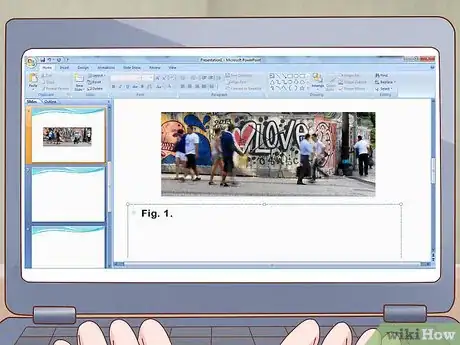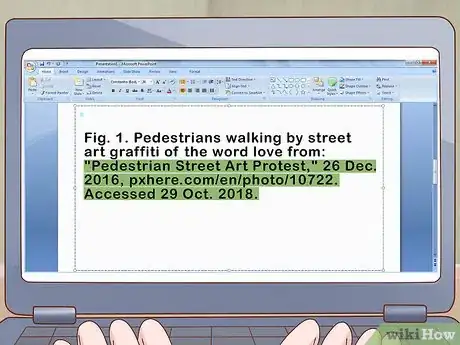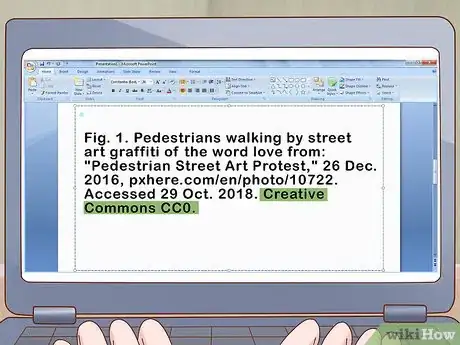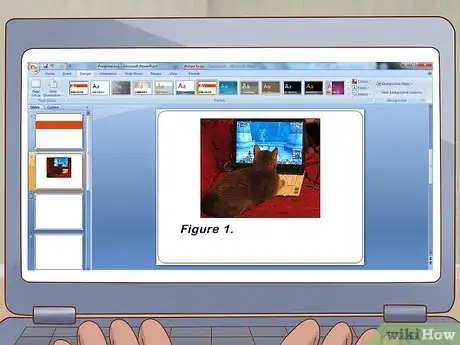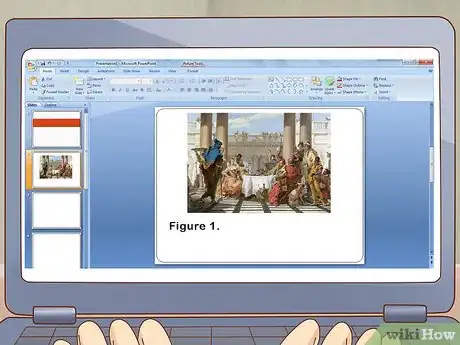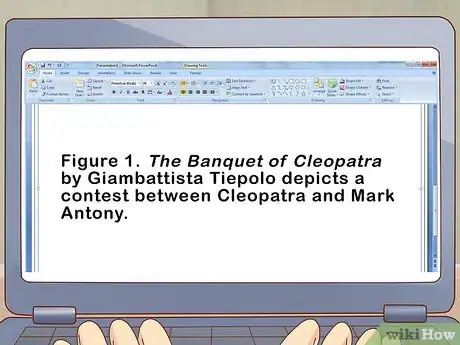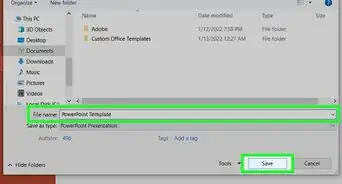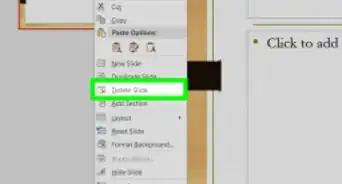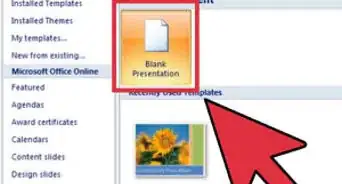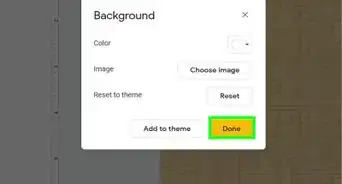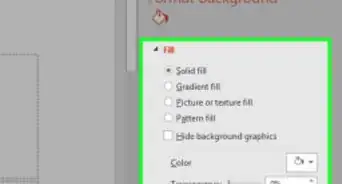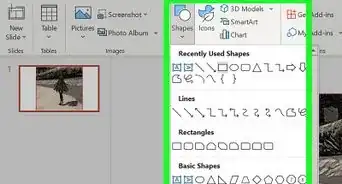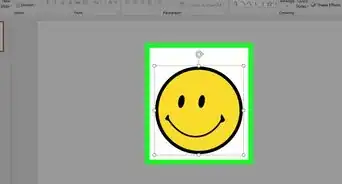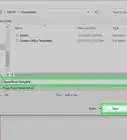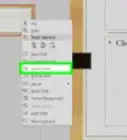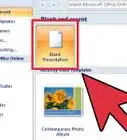This article was co-authored by wikiHow staff writer, Jennifer Mueller, JD. Jennifer Mueller is a wikiHow Content Creator. She specializes in reviewing, fact-checking, and evaluating wikiHow's content to ensure thoroughness and accuracy. Jennifer holds a JD from Indiana University Maurer School of Law in 2006.
This article has been viewed 259,755 times.
Learn more...
When you're preparing a presentation using PowerPoint, you need to cite all images used that you didn't create yourself. This includes graphs or tables that you may have copied from a book, website, or other source. Unlike a text citation, an image caption in a slide presentation also includes a copyright or license statement. While this may sound complex, it's usually pretty simple if you know where to look. Beyond that, the format for your caption varies depending on whether you're using Modern Language Association (MLA), American Psychological Association (APA), or Chicago citation style.[1]
Steps
Template and Examples
MLA
-
1Provide a figure number for the image. Figures are labeled using the abbreviation "Fig." followed by a sequential number. If it's the first image in your presentation, it would be "Fig. 1." Type both the abbreviation and the number in bold type. Place a period after the number.[2]
- Example: Fig. 1.
-
2Include a title or description of the image. If the image is titled, type that title enclosed in quotation marks. If it doesn't have a title, provide a brief description of the image. Then type the word "from," followed by a colon.[3]
- Example: Fig. 1. Pedestrians walking by street art graffiti of the word love from:
Advertisement -
3Identify where you got the image from with a full citation. Include a full Works Cited entry for the source of the image in the image caption. MLA does not require an additional entry in the Works Cited for your presentation.[4]
- Example: Fig. 1. Pedestrians walking by street art graffiti of the word love from: "Pedestrian Street Art Protest," 26 Dec. 2016, pxhere.com/en/photo/10722. Accessed 29 Oct. 2018.
- If the image is available online, include a direct URL to the web page where the image can be found, instead of a page number.
-
4Close with copyright or Creative Commons license status. If you have reproduced the image in your presentation slides, copyright or license details are required in the caption. Typically this information will be listed directly below the image. If you cannot find copyright or license details for the image, do not reproduce the image in your presentation. Place a period at the end of the copyright or license information.[5]
- Example: Fig. 1. Pedestrians walking by street art graffiti of the word love from: "Pedestrian Street Art Protest," 26 Dec. 2016, pxhere.com/en/photo/10722. Accessed 29 Oct. 2018. Creative Commons CC0.
MLA Caption Format
Fig. x. Description of image from: Last Name, First Name. "Title of Original Image." Publication, Day Month Year, p. x. Copyright or CC License.
APA
-
1Label the image with a figure number. Immediately under the image, type the word "Figure" in italics, followed by a number for the image. Your numbers should be sequential throughout your presentation. Type the word and number in italics. Place a period after the number.[6]
- Example: Figure 1.
-
2Provide a description of the image in your caption. The image in your presentation is a reproduction of the original. Since the title only applies to the original, APA style requires a description. Type your description in sentence case, capitalizing only the first word and any proper nouns. Place a period at the end of your description.[7]
- Example: Figure 1. Cat watching World of Warcraft on a laptop.
-
3Include information about where you found the image. Type the words "Adapted from," then provide the title of the image, the creator of the image, and the location of the image. Since typically you'll pull an image from the internet, include a URL for the image.[8]
- Example: Figure 1. Cat watching World of Warcraft on a laptop. Adapted from "World of Warcraft Obsession," by Stacina, 2004, retrieved from https://www.flickr.com/photos/staci/14430768.
-
4Close with copyright or Creative Commons license information. Copyright or license details indicate that you have permission to copy the image and use it in your presentation. If the image has a creative commons license, use the abbreviation listed. Place a period at the end of the copyright or license information.[9]
- Example: Figure 1. Cat watching World of Warcraft on a laptop. Adapted from "World of Warcraft Obsession," by Stacina, 2004, retrieved from https://www.flickr.com/photos/staci/14430768. CC BY-NC-SA 2.0.
APA Caption Format
Figure 1. Description of image in sentence case. Adapted from "Title of Original Image," by Artist, Year, retrieved from URL.
-
5Include a reference list entry in addition to the caption. APA style does not require a full citation in the caption for the image. Rather, the full citation is included in your references. Follow the basic APA format for citing an image.[10]
- Example: Stacina. (2004). World of Warcraft Obsession [photograph]. Retrieved from https://www.flickr.com/photos/staci/14430768.
APA Reference List Citation Format
Artist Last Name, First Initial. Middle Initial. (Year). Title of image in sentence case [Description of format]. Retrieved from URL.
Chicago
-
1Give the image a figure number. Begin your caption immediately under the image. Start the caption by typing the word "Figure" followed by a sequential number. Place a period after the number.[11]
- Example: Figure 1.
-
2Provide a caption for the image. Include the title and name of the artist in your caption, writing a brief sentence that ties the image into the rest of your presentation. Depending on the image, the caption may also describe what is depicted in the image, or how it is related to your presentation.[12]
- Example: Figure 1. The Banquet of Cleopatra by Giambattista Tiepolo depicts a contest between Cleopatra and Mark Antony.
-
3Include a full citation for the image in a footnote. The superscript number for your footnote may be in the text of your presentation, or at the end of the caption. In the footnote, list the name of the artist, title of the work, date of creation, and where you found the image. You may also include the dimensions of the original artwork and materials used, if relevant.[13]
- Example: Giambattista Tiepolo, The Banquet of Cleopatra, 1743-44, oil on canvas, 250.3 x 357.0 cm, accessed 24 May 2018, http://www.ngv.vic.gov.au/col/work/4409.
- For slide presentations, you may use endnotes instead of footnotes, to keep your slides clean. The format remains the same.
Chicago Footnote Format
Artist First Name, Last Name, Title of Image, Year, materials, dimensions, accessed Day Month Year, URL.
References
- ↑ http://writeanswers.royalroads.ca/faq/199200
- ↑ https://columbiacollege-ca.libguides.com/mla/images
- ↑ https://columbiacollege-ca.libguides.com/mla/images
- ↑ https://columbiacollege-ca.libguides.com/mla/images
- ↑ https://library.carleton.ca/find/images/citing-images/mla-bibliographic-entries-images-and-figure-captions
- ↑ http://libraryfaqs.cu-portland.edu/faq/103029
- ↑ http://libraryfaqs.cu-portland.edu/faq/103029
- ↑ http://libraryfaqs.cu-portland.edu/faq/103029
- ↑ http://libraryfaqs.cu-portland.edu/faq/103029
- ↑ http://libraryfaqs.cu-portland.edu/faq/103029
- ↑ https://guides.lib.monash.edu/c.php?g=219786&p=1454474
- ↑ https://guides.lib.monash.edu/c.php?g=219786&p=1454474
- ↑ https://guides.lib.monash.edu/c.php?g=219786&p=1454474
- ↑ https://owl.purdue.edu/owl/research_and_citation/mla_style/mla_formatting_and_style_guide/mla_tables_figures_and_examples.html

